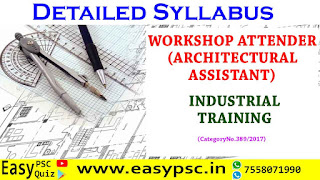FURTHER DETAILS REGARDING MAIN TOPICS OF
Program No. 11/2019 (Item No.13)
WORKSHOP ATTENDER
(ARCHITECTURAL ASSISTANT)
(SR FROM SC/ST)
INDUSTRIAL TRAINING
(CategoryNo.389/2017)
1. Engineering Drawing and AUTOCAD:
Lettering, Construction of plain geometrical figures (lines, angles, triangles, rhombus, quadrilaterals, polygons, ellipse, parabola, hyperbola, etc). Projection of solids in simple positions (pyramid, prism, cylinder, cone, sphere, cube). Projection of solids in Inclined positions (pyramid, prism, cylinder, cone, sphere, cube) Isometric projection of different objects, a combination of objects including furniture, etc version of orthographic projection to isometric projection and vice versa.
AUTOCAD: Initial sketches/preliminary drawings in CAD
Application of fractions and decimals to trade problems. Ratio and proportion of units – different system and conversion Algebra – simple equation, problems involving trade Units of mass, force, weight, and simple problems Mensuration: Problems related to triangles, rectangles, squares, circle, regular polygons, etc Trigonometrical ratios, functions – applied problems, height and distance Calculation on volume and weight of simple solid bodies
MASONRY:
Definition, classification, properties, and uses of brick Characteristics of good brick. Sizes of brick.
English and Flemish bond- for half brick thick and one brick thick wall. Tools and equipment used in Brick masonry. Stonemasonry Coarse and uncoated rubble and random rubble masonry Ashlar chamfered masonry. Technical terms Principles of stone masonry Classification of stone masonry.
Lime - Definition, classification, properties and uses of lime Surkhi - Definition and uses Sand - Definition, uses and classification. Cement - Definition, composition, types, properties and uses Mortar - Definition, function, types, uses and proportion of mortar Concrete - Definition, proportions, properties and uses, Grades (M20, M15, M35 etc.)
FOUNDATION AND DPC:
Types of foundation (pile, raft, spread, mat, column, retaining wall). Foundation Purpose, causes of failure of foundation, bearing capacity of soils, dead load, live load Types of foundation (pile, raft, spread, mat, column, retaining wall). DPC: Sources of dampness Effects of dampness Method of prevention of dampness in building Periodic repair and care for prevention Anti termite treatment.
Floors& Flooring roof & roof coverings, Color wheel, Color schemes, and Paints, etc:-
Floors: Components of floor Ground and basement floor
Flooring: Types and its laying process (terrazzo, concrete, granite, marble, tiles, rubber, wooden)
Roof and roof coverings: Pitched roof, flat roof, lean-to roof Materials used for roofing like an asbestos sheet, terracotta tiles, AC sheets, corrugated sheets, etc
Color: Definition of color Qualities of color Color wheel Properties of color Methods of pencil use Pencil grades.
Paint – types, characteristics, and procedure Polishing – types, characteristics, and procedure (lacquer, melamine, deco, French polish, polyurethane polish)
Doors, Windows, Arches, Lintels, Stairs, Timber, and Carpentry Joints:
Doors: Details of Paneled door, flush door, batten, and ledged door. Types of doors. Size of the doors Door frame.
Windows: Classification of windows.Size of the window.
Basement window, louvered window, ventilator, and its details. Hardwood and softwood Defects in timber Characteristics of common Indian timber (Sal, deodar, teak, chir, kail, neem).
Arches: Types of arches (flat arch, semi-circular arch, segmental arch) Technical terms Classification of arches
Lintels: Materials used for construction Lintels Purpose and types (wooden lintels, brick lintel, stone lintel, reinforced concrete lintel, steel lintel).
Stairs: Technical terms used Materials used for different types of stairs Planning and design of a stair Details of construction of various stairs. Classification of timber joints.
Water supply system, Sanitation, and drainage, Mechanical services, Rainwater harvesting, Estimation, Bending moment and shear force, Theory of RCC beams/slabs, Design of beams and columns:
Water supply: Average water consumption for various building Water distribution in a domestic building, sanitation Terms used in Public Health Engineering.
Sanitation and drainage: System of sewerage – one-pipe system, two-pipe system, single stack system, anti siphonage pipe Types of traps Sanitary fitting – WV, urinals, sinks, WCs Septic tank, and stormwater drainage Sewage treatment – primary treatment, secondary treatment.
Mechanical services: HVAC – window unit, split unit, duct able unit, chilled beam system Lifts and escalators Firefighting services
Rainwater harvesting: Purpose, advantages, the system set up and various process.
Estimation: Introduction Standard methods of calculating quantities – centerline method, in to in – out to out method Types of estimate Performa’s used in estimate Abstract cost Material statement Unit of measurement.
Preparation of Detailed estimate: Excavation Footings Superstructure Concrete works (lintel, beam, column, slab) Roofing – flat roof Flooring Doors and windows Plastering and painting.
Rate analysis and Specifications:
Specifications – importance, objectives Rate analysis of items (concrete, brickwork, woodwork, plastering, flooring) including rates of Labour and materials, sundries, contractors profit, etc as per standards.
Bending moment and shear force: Types of beams – cantilevers, simply supported and overhanging beams Types of loads – concentrated, U.D.L and uniformly increasing loads Calculation of B.M and S.F for simply supported, cantilever and overhanging beams subjected to concentrate and UDL only.
Theory of RCC beams – singly reinforced: Simple bending assumptions. Flexible strength of aq single reinforced RCC beam Neutral axis Concept of the balanced section, under the reinforced section, over reinforced section Shear strength of single reinforced RCC beams Assumptions made in single reinforced RCC beams. Bonds in RCC beams/slabs Property of bonds, the minimum length of embedment of bars Bond length anchorage as per IS specification.
Design of beams and columns.
Surveying and Levelling:
Chain Survey Testing of the chain, direct ranging, indirect ranging, degree of accuracy. Compass surveying Prismatic compass, surveyors compass, advantages, and disadvantages Plane table survey General, an instrument used advantages and disadvantages, orientation, methods used. Leveling. Introduction in leveling Types of leveling and leveling staff Terms used in leveling Booking and reduction levels. Total survey station Components used in total survey station Advantages of total survey station Electronic notebook.
NOTE: - It may be noted that apart from the topics detailed above,
questions from other topics prescribed for the educational
qualification of the post may also appear in the question paper.
There is no undertaking that all the topics above may be covered in
the question paper


.png)







